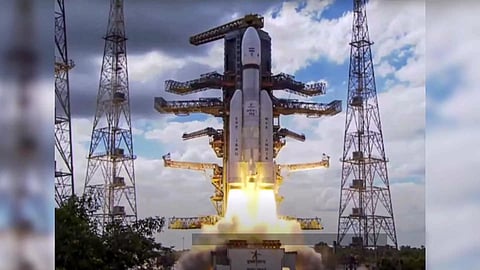

BENGALAURU: India's third unmanned Moon mission Chandrayaan-3 on Saturday successfully entered the lunar orbit, 22 days after it was launched for a far more complicated 41-day voyage to reach the lunar south pole where no other nation has gone before.
''I am feeling lunar gravity,'' was Chandrayaan-3's message to the ISRO after the required maneuver that brought it closer to the moon was carried out without any glitch from the space facility in Bengaluru. The injection into the lunar orbit marked a major milestone in the space agency's ambitious Rs 600 crore mission.
The spacecraft has covered about two-thirds of the distance to the Moon since its launch on July 14 and the next 18 days will be crucial for the Indian Space Research Organisation(ISRO).
The ISRO shared a message from the satellite to its centres, which read,'' MOX, ISTRAC, this is Chandrayaan-3. I am feeling lunar gravity''.
''Chandrayaan-3 has been successfully inserted into the lunar orbit. A retro-burning at the Perilune was commanded from the Mission Operations Complex (MOX), ISTRAC (ISRO Telemetry, Tracking and Command Network), Bengaluru,'' the space agency said. Perilune is the spacecraft's closest point to the moon.
The next operation--reduction of orbit--will be done at 11 PM on Sunday, the ISRO said in a tweet.
After the Sunday maneuver tomorrow, there will be three more operations till August 17 following which the Landing Module Vikram carrying the rover Pragyan inside will break away from the Propulsion Module. After this, de-orbiting maneuvers will be carried on the lander before the final powered descent on the moon.
Shortly after Chandrayaan-3 took off on July 14 from the Satish Dhawan Space Centre in Sriharikota in Andhra Pradesh piggybacking on the heavylift LVM3-M4 rocket, ISRO Chairman S Somanath said if everything goes as per plan it will attempt the technically challenging soft landing on the lunar surface at 5.47 pm on August 23.
Over five moves in the three weeks since the launch on July 14, the ISRO has been lifting the Chandrayaan-3 spacecraft into orbits farther and farther away from the Earth.
Then, on August 1 in a key maneuver -- a slingshot move -- the craft was sent successfully towards the moon from Earth's orbit.
Following this trans-lunar injection, the Chandrayaan-3 spacecraft escaped from orbiting the Earth and began following a path that would take it to the vicinity of the moon.
After reaching close to the moon, the spacecraft will need to be captured by its gravity. Once that happens, another series of manoeuvres will reduce the orbit of the spacecraft to a 100×100 km circular one.
If Chandrayaan-3 succeeds in landing a robotic lunar rover in ISRO's second attempt in four years, India will become the fourth country to master the technology of soft-landing on the moon's surface after the US, China and the former Soviet Union.
Chandrayaan-2 had failed in its lunar phase when its lander 'Vikram' crashed into the surface of the moon following anomalies in the braking system in the lander while attempting a soft landing on September 7, 2019. Chandrayaan's maiden mission was in 2008.
The significance about Chandrayaan-3 mission, unlike its unsuccessful predecessor, is that the Propulsion Module has a payload -- SHAPE -- Spectro- polarimetry of HAbitable Planet Earth which is to study earth from lunar orbit.
The ISRO said the SHAPE is an experimental payload to study the spectro-polarimetric signatures of the Earth in the near-infrared wavelength range.
Apart from the SHAPE payload, the Propulsion Module's main function is to carry the Lander Module from launch vehicle injection orbit till lander separation.
The Lander Module after landing on the surface of the moon has payloads including RAMBHA-LP which is to measure the near surface plasma ions and electrons density and its changes, ChaSTE Chandra's Surface Thermo Physical Experiment -- to carry out the measurements of thermal properties of lunar surface near polar region-- and ILSA (Instrument for Lunar Seismic Activity) to measure seismicity around the landing site and delineating the structure of the lunar crust and mantle.
The rover, after the soft-landing, would come out of the Lander Module and study the surface of the moon through its payloads APXS - Alpha Particle X-Ray Spectrometer - to derive the chemical composition and infer mineralogical composition to further enhance understanding of the lunar surface.
The rover, which has a mission life of 1 lunar day (14 Earth days), also has another payload Laser Induced Breakdown Spectroscope (LIBS) to determine the elemental composition of lunar soil and rocks around the lunar landing site.